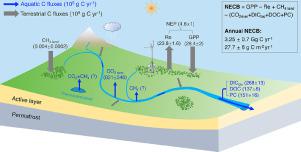当前位置:
X-MOL 学术
›
Agric. For. Meteorol.
›
论文详情
Our official English website, www.x-mol.net, welcomes your feedback! (Note: you will need to create a separate account there.)
Net ecosystem carbon budget of a grassland ecosystem in central Qinghai-Tibet Plateau: integrating terrestrial and aquatic carbon fluxes at catchment scale
Agricultural and Forest Meteorology ( IF 6.2 ) Pub Date : 2020-08-01 , DOI: 10.1016/j.agrformet.2020.108021 Chunlin Song , Genxu Wang , Zhaoyong Hu , Tao Zhang , Kewei Huang , Xiaopeng Chen , Yang Li
Agricultural and Forest Meteorology ( IF 6.2 ) Pub Date : 2020-08-01 , DOI: 10.1016/j.agrformet.2020.108021 Chunlin Song , Genxu Wang , Zhaoyong Hu , Tao Zhang , Kewei Huang , Xiaopeng Chen , Yang Li

|
The effects of aquatic carbon exports on grassland ecosystem carbon balance is unclear. Here we quantified the seasonal and annual net ecosystem carbon budget (NECB) of an alpine grassland ecosystem in the Qinghai-Tibet Plateau (QTP) permafrost region with integrative terrestrial and aquatic carbon flux measurements. The terrestrial carbon fluxes, including the net ecosystem production (NEP) and CH4 flux, were derived from eddy covariance and previous chamber-based measurements. The aquatic carbon fluxes, including dissolved organic carbon, biogenic dissolved inorganic carbon, particulate carbon, and riverine CO2 efflux of the catchment, were determined with stream monitoring. We found that NECB exhibited distinct seasonal features for the grassland ecosystem, which shifted from a carbon sink in growing season (68.8 +/- 8.7 g C m(-2)) to a carbon source in nongrowing season (- 41.1 +/- 2.4 g C m(-2)), while the NECB (27.7 +/- 6 g C m(-2) yr(-1)) demonstrated a net carbon sink at an annual basis. The total aquatic carbon flux (TAC, 11.8 +/- 1.5 g C m(-2) yr(-1)) offset 14% of the land carbon assimilation for growing season and 30% of the annual land carbon assimilation after subtracting ecosystem respiration. The higher TAC/NEP ratios in low NEP months indicated that aquatic carbon was more important on offsetting terrestrial carbon sink when NEP was low. Our results show a large contribution of aquatic carbon to NECB in a QTP grassland ecosystem, which suggest that disregarding the aquatic carbon flux can substantially overestimate the strength of terrestrial carbon sink. As aquatic carbon is coupled with hydrological processes, TAC is crucially important for NECB in the cryosphere ecosystem since the drastic hydrology and permafrost change can transport more soil carbon into the fluvial networks. More studies on NECB is needed, especially when the ecosystem have a low NEP and actively changing hydrological processes.
中文翻译:

青藏高原中部草地生态系统净生态系统碳收支:流域尺度陆地和水体碳通量的整合
水生碳输出对草地生态系统碳平衡的影响尚不清楚。在这里,我们通过综合陆地和水生碳通量测量量化了青藏高原 (QTP) 多年冻土区高寒草地生态系统的季节性和年度净生态系统碳收支 (NECB)。陆地碳通量,包括净生态系统产量 (NEP) 和 CH4 通量,来自涡流协方差和之前基于腔室的测量。流域的水生碳通量,包括溶解有机碳、生物溶解无机碳、颗粒碳和河流 CO2 流出,通过河流监测确定。我们发现 NECB 对草地生态系统表现出明显的季节性特征,其从生长季节的碳汇转移 (68.8 +/- 8. 7 g C m(-2)) 到非生长季节的碳源 (- 41.1 +/- 2.4 g C m(-2)),而 NECB (27.7 +/- 6 g C m(-2) yr( -1)) 展示了每年的净碳汇。总水生碳通量 (TAC, 11.8 +/- 1.5 g C m(-2) yr(-1)) 抵消了生长季陆地碳同化的 14% 和减去生态系统呼吸后每年陆地碳同化的 30% . 低 NEP 月份较高的 TAC/NEP 比率表明,当 NEP 较低时,水生碳在抵消陆地碳汇方面更为重要。我们的研究结果表明,在 QTP 草原生态系统中,水生碳对 NECB 的贡献很大,这表明忽视水生碳通量会大大高估陆地碳汇的强度。由于水生碳与水文过程耦合,TAC 对于冰冻圈生态系统中的 NECB 至关重要,因为剧烈的水文和永久冻土变化可以将更多的土壤碳输送到河流网络中。需要对 NECB 进行更多研究,尤其是当生态系统的 NEP 较低且水文过程发生积极变化时。
更新日期:2020-08-01
中文翻译:

青藏高原中部草地生态系统净生态系统碳收支:流域尺度陆地和水体碳通量的整合
水生碳输出对草地生态系统碳平衡的影响尚不清楚。在这里,我们通过综合陆地和水生碳通量测量量化了青藏高原 (QTP) 多年冻土区高寒草地生态系统的季节性和年度净生态系统碳收支 (NECB)。陆地碳通量,包括净生态系统产量 (NEP) 和 CH4 通量,来自涡流协方差和之前基于腔室的测量。流域的水生碳通量,包括溶解有机碳、生物溶解无机碳、颗粒碳和河流 CO2 流出,通过河流监测确定。我们发现 NECB 对草地生态系统表现出明显的季节性特征,其从生长季节的碳汇转移 (68.8 +/- 8. 7 g C m(-2)) 到非生长季节的碳源 (- 41.1 +/- 2.4 g C m(-2)),而 NECB (27.7 +/- 6 g C m(-2) yr( -1)) 展示了每年的净碳汇。总水生碳通量 (TAC, 11.8 +/- 1.5 g C m(-2) yr(-1)) 抵消了生长季陆地碳同化的 14% 和减去生态系统呼吸后每年陆地碳同化的 30% . 低 NEP 月份较高的 TAC/NEP 比率表明,当 NEP 较低时,水生碳在抵消陆地碳汇方面更为重要。我们的研究结果表明,在 QTP 草原生态系统中,水生碳对 NECB 的贡献很大,这表明忽视水生碳通量会大大高估陆地碳汇的强度。由于水生碳与水文过程耦合,TAC 对于冰冻圈生态系统中的 NECB 至关重要,因为剧烈的水文和永久冻土变化可以将更多的土壤碳输送到河流网络中。需要对 NECB 进行更多研究,尤其是当生态系统的 NEP 较低且水文过程发生积极变化时。



























 京公网安备 11010802027423号
京公网安备 11010802027423号